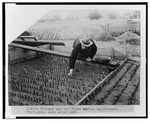Luther Burbank
Luther Burbank (March 7, 1849 – April 11, 1926) was an American botanist, horticulturist, and pioneer in agricultural science. He developed more than 800 strains and varieties of plants over his 55-year career. Burbank's most notable achievements include the development of the Russet Burbank potato, which helped alleviate the Great Irish Famine and is still widely used in the fast food industry today, particularly for French fries.
Early Life[edit | edit source]
Luther Burbank was born in Lancaster, Massachusetts, to Samuel Walton Burbank and Olive Ross Burbank. From a young age, he showed a keen interest in plants and nature, which was encouraged by his mother. After receiving a high school education, Burbank used his inheritance from his father's death to buy a 17-acre plot of land near Lunenburg, Massachusetts, where he began his plant breeding experiments.
Career[edit | edit source]
In 1875, Burbank sold his first commercial plant, the Burbank potato, and used the proceeds to move to Santa Rosa, California, where he purchased a 4-acre plot that would become the site of his experimental farms. Burbank's work in Santa Rosa, and later in Sebastopol, California, involved crossbreeding plants to create new varieties with desirable traits, such as disease resistance, improved yield, and enhanced taste.
Burbank's approach to plant breeding was empirical and based on the principle of natural selection. He introduced the concept of hybrid vigor and was one of the first to apply the principles of genetics to the practice of plant breeding, although he did not use the scientific terminology of his time.
Among Burbank's most famous creations are the Shasta daisy, the fire poppy, the July Elberta peach, the Santa Rosa plum, and the Flaming Gold nectarine. His work with the spineless cactus was particularly notable for its potential to provide a reliable food source for livestock in arid regions.
Legacy[edit | edit source]
Luther Burbank's contributions to agriculture and horticulture are immense. He was widely recognized during his lifetime and received numerous awards and honors. The Luther Burbank Home and Gardens in Santa Rosa is a registered National Historic Landmark dedicated to his life and work.
Burbank was a contemporary of Thomas Edison and Henry Ford, and like them, he was a prolific inventor, although his medium was living plants rather than technology. His methods and discoveries laid the groundwork for modern plant breeding and genetic engineering.
Despite his success, Burbank's work was also subject to criticism, particularly from those who opposed his non-scientific approach and lack of formal documentation. Nevertheless, his legacy as a pioneer in the field of plant breeding and genetics is undisputed.
Death and Memorials[edit | edit source]
Luther Burbank died on April 11, 1926, in Santa Rosa. His gravesite is located at the Luther Burbank Home and Gardens. In addition to the national historic landmark dedicated to him, Burbank's influence is commemorated in various ways, including the naming of schools, parks, and other institutions after him.
See Also[edit | edit source]
Search WikiMD
Ad.Tired of being Overweight? Try W8MD's physician weight loss program.
Semaglutide (Ozempic / Wegovy and Tirzepatide (Mounjaro / Zepbound) available.
Advertise on WikiMD
|
WikiMD's Wellness Encyclopedia |
| Let Food Be Thy Medicine Medicine Thy Food - Hippocrates |
Translate this page: - East Asian
中文,
日本,
한국어,
South Asian
हिन्दी,
தமிழ்,
తెలుగు,
Urdu,
ಕನ್ನಡ,
Southeast Asian
Indonesian,
Vietnamese,
Thai,
မြန်မာဘာသာ,
বাংলা
European
español,
Deutsch,
français,
Greek,
português do Brasil,
polski,
română,
русский,
Nederlands,
norsk,
svenska,
suomi,
Italian
Middle Eastern & African
عربى,
Turkish,
Persian,
Hebrew,
Afrikaans,
isiZulu,
Kiswahili,
Other
Bulgarian,
Hungarian,
Czech,
Swedish,
മലയാളം,
मराठी,
ਪੰਜਾਬੀ,
ગુજરાતી,
Portuguese,
Ukrainian
Medical Disclaimer: WikiMD is not a substitute for professional medical advice. The information on WikiMD is provided as an information resource only, may be incorrect, outdated or misleading, and is not to be used or relied on for any diagnostic or treatment purposes. Please consult your health care provider before making any healthcare decisions or for guidance about a specific medical condition. WikiMD expressly disclaims responsibility, and shall have no liability, for any damages, loss, injury, or liability whatsoever suffered as a result of your reliance on the information contained in this site. By visiting this site you agree to the foregoing terms and conditions, which may from time to time be changed or supplemented by WikiMD. If you do not agree to the foregoing terms and conditions, you should not enter or use this site. See full disclaimer.
Credits:Most images are courtesy of Wikimedia commons, and templates, categories Wikipedia, licensed under CC BY SA or similar.
Contributors: Prab R. Tumpati, MD






